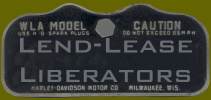

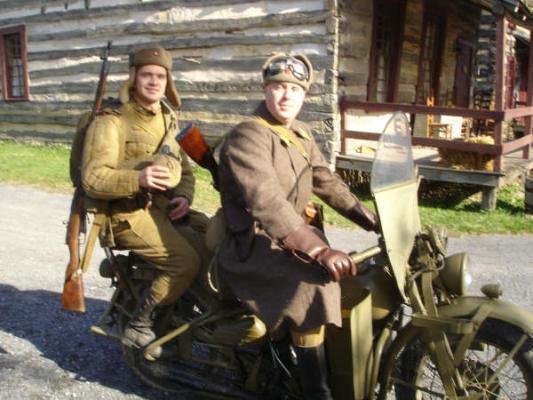
Photo: David Thomas
Dave Thomas and a friend on
Dave's WW2 Russian 'Lend-Lease' WLA impression
Introduction
Addressing the subject
of 'Lend-Lease' isn't easy. Details of the transfer of vehicles and equipment by
the US Government to other nations during WW2 remain highly obscure, even after
all these years. However seeing that more than half of the WLAs produced during
WW2 were shipped to other countries makes a closer look at 'Lend-Lease' an
absolute necessity.
The information on this page is as far as I know correct and was verified thru
different sources. It is however possible that flaws or inaccuracies occur on
this page and I appreciate any feedback and corrections that could be added.
At this point too, I would like to express my gratitude and thanks to Martin Bogaert, the
Indian Model 340 CAV Guru, who helped me tremendously in getting tru the
'Lend-Lease' maze, as well as all others that 'lend-leased' me with photos or
information....
Yes, there's lots of text to be read, but there are pictures too ;-)
'Lend-Lease'
Early 1940, 50 US-Navy destroyers were transferred to the
British and Canadian
Royal
Navies in exchange for basing rights in the
Caribbean and Newfoundland,
in a program which was known as the 'Destroyers
for Bases Agreement'.
And after June 17th, 1940; 475 Indian Model
340 CAV Motorcycles,
manufactured for France, were transferred to the United Kingdom and Canada.
These motorcycles were initially part of a batch produced by the
Indian Motocycle Company for the French Army. However the fall of France,
followed by the occupation by the German Army, made delivery of this batch
impossible and they were diverted to Britain and Canada (325 and approximately 150
respectively).
These events gave birth to the later 'Lend-Lease Act'.
'Lend-Lease' began
in March 1941, long before the US entered WW2, and almost 9 months before the
Japanese attack on Pearl Harbor. Under that name the
United
States of America initiated a program during which they supplied
Great
Britain, the
Soviet
Union,
China,
France
and other Allied
nations with vast amounts of
war
materiel
(i.e. vehicles, motorcycles, guns,
ammunition, engineering equipment, tents, clothing, etc....)
between 1941 and 1945.
The
'Lend-Lease Act'
passed on March 11th 1941,
permitted the President of the United States to "sell, transfer title to,
exchange, lease, lend, or otherwise dispose of, any
defense article to any such government, whose
defense the President deems vital to the defense of the United States".
In April 1941, this policy was extended to China. China had been at war with
Japan since 1937 and it might well have been the intention of the US to support
China in a war against a future common enemy.
At the end of October 1941,
President Roosevelt approved 1 billion USdollars in 'Lend-Lease' aid to Britain
, who was then at war with Germany and about six weeks before Germany declared
war on the US.
Simultaneously the US Army ran a program called Motor Vehicle Defense Aid (DA)
in which vehicles for other nations were contracted and paid for by the US Army
through the Quartermaster Corps, but by the end of 1941, once the US was
actively involved in WW2, all foreign supply activity would be known as 'Lend-Lease'.
President Franklin D. Roosevelt, eager to ensure public consent for this controversial plan, explained to the public and the press that his plan was comparable to one neighbor lending another a garden hose to put out a fire in his home. The president asked at a press conference: "What do I do in such a crisis?" "I don't say... 'Neighbor, my garden hose cost me $15; you have to pay me $15 for it' …I don't want $15 — I want my garden hose back after the fire is over."
President Roosevelt set up the Office of
'Lend-Lease' Administration in 1941,
appointing steel executive Edward
R. Stettinius as head. In September 1943, Stettinius was promoted to Undersecretary
of State, and banker Leo
T. Crowley became head of Lend Lease which then became part of the
Foreign Economic Administration, also known as the FEA.
'Lend-Lease' aid to Russia was nominally managed by Stettinius. Roosevelt's
Soviet Protocol Committee, dominated by Harry
Hopkins and General John York, who were totally sympathetic to the provision
of "unconditional aid." Until 1943, few Americans objected to Russian
aid.
The 'Lend-Lease' program was abruptly stopped by the Americans immediately after V-J day. It is not clear how much of the equipment was returned or paid for. In return for these goods, some countries provided the US troops with camps and bases in their country or put their industry to work to manufacture uniforms, equipment or other goods for the US Army. Best known examples of this, are the 'British Made for US Army' uniforms and equipment; a production which is sometimes referred to as 'Reverse-Lend-Lease'.
The 'Lend-Lease' deliveries consisted of hundreds of different items, all described under the general term of 'Defense Articles'. Ilya Grinberg's excellent website describes the different shipments in detail and has lists of all quantities that were sent around the globe.
'Lend-Lease' WLAs
A total of 38.103 WLAs were supplied to Allied Nations under the
'Lend-Lease Act'; which means that more than half of total WW2 production was actually
supplied to, and used
by, Armies other than the United States'.....
It seems that mostly Type IV
or later bikes were supplied to other nations, with the exception being the
Type I and II's that were shipped to China and Brazil. Except for these early bikes, which
were delivered under the Defense Aid Program, all 'Lend-Lease' bikes were issued
US Army Registration Numbers painted in 1" blue drab numbers on the rear
fender under the lights.
The table below,
taken from Page 13 of the
Lend-Lease Part 3B shows how many bikes
were delivered to other Nations in 'Lend-Lease'
Click
HERE to see the complete listing of 'Lend-Lease' delivered Motorcycles, as
published on Ilya Grinberg's
website described above.
|
Lend-Lease Part 3B – Page 13 |
|||
|
Line |
Item Description: |
Totals |
Remarks |
| 5 | Solo, Chain Drive, 45 cu in | 38,103 | Harley-Davidson WLA |
| 6 | Solo, 30.50 cu in | 26,914 | Indian Model 741 |
| 7 | Chain Drive, w/sidecar | 1,789 |
Indian Model 340 Indian Model 344 |
This list appears courtesy of Martin Bogaert
Countries that
received the WLA (or maybe even the WLC?) were: The USSR (26.670), The British Empire (8.686),
French Forces (926), China (1.000), Brazil (45), Other Latin-American
Republics (156), The Netherlands (420) and the FEA (200).
Other countries that may have been supplied with WLAs thru the Foreign Economic
Administration (FEA) are Belgium, Ethiopia, Greece, Iran, Norway, Poland, Saudi
Arabia, Turkey and Yugoslavia, but sources are not clear about this. Also note that
the 'British Empire' consists not only of the United Kingdom, but also of
Australia, New-Zealand and other regions of the Empire at that time. Canada did
not receive the Harley-Davidson under 'Lend-Lease' but purchased the Model WLC
separately for the Canadian National Defence Force. For more information on the
Model WLC, click HERE!
No wonder Liberators turned up all over the world, once hostilities ended and military motorcycles were sold as surplus.... And as far as Roosevelt's proverbial garden hose is concerned..... It seems none were returned after WW2.........
The Russian Connection
In 1993, I started to
shop around for a restorable WLA project. I got in touch with a guy who imported
WLAs and parts from Russia. He showed me a WLA, fitted with Ndjepr front forks
and modified beyond possible restoration....
The Iron Curtain had just come down and in the following months I heard more and
more rumors about he vast quantities of WLAs that were still available in the
former USSR. Years went by without further research about those Russian WLAs,
but the import of bikes and parts from Europan former-communist countries
increased al thru the 90's....
Finally thru networking and asking around, I began to have a good view on the
reason why so many bikes were still around in Moscow, Saint-Petersburg and other
Russian cities..... It was 'Lend-Lease' that ensured the delivery of thousands
of WLAs to the USSR during WW2, and even today hundreds, if not thousands, of
them are still around, some in remarkably good condition....
Knowing how the Cold War
influenced Eastern versus Western relationships and that for more than 40 years,
threat of nuclear war was never out of people's minds; it might seem odd and
hard to comprehend that it was the USSR who received the largest amount of
supplies from the USA during WW2.
Stalin and the Red Army were Allies during WW2 with Germany being the common
enemy; so supplying Russia with everything it needed to fight the Germans on the
Eastern front probably seemed the right thing to do.....
American deliveries to the Soviet Union can be divided into the following phases:
Pre 'Lend-Lease': June 22th, 1941 (Start of German Operation Barbarossa) to September 30th, 1941 (paid for in gold)
First Protocol: October 1st, 1941 to June 30th, 1942 (signed October 1st, 1941)
Second Protocol: July 1st, 1942 to June30th, 1943 (signed October 6th, 1942)
Third Protocol: July 1st, 1943 to June 30, 1944 (signed October 19t, 1943)
Fourth Protocol: July 1st, 1944, (signed April 17th, 1945), formally ended May 12th, 1945 but deliveries continued for the duration of the war with Japan (which the Soviet Union entered on August 8th, 1945) under the 'Milepost' agreement until September 2nd, 1945 when Japan capitulated.
September 20th, 1945: All 'Lend-Lease' to Russia was terminated
All sorts of equipment and supplies were delivered to the USSR during WW2; equipment which included 7.056 Tanks, 51.503 Jeeps (Willys MB....), 375.883 Trucks (Studebaker....), 11.205 Bicycles, 131.633 Machine Guns, 3.786.000 Tires, 15.417.001 Pairs of shoes and.......34.190 Motorcycles!!!!! Of these 34.190 Motorcycles, 26.670 of them were Harley-Davidson Model 42WLA!.....The other models were Indian Models 741, 340 and 344....
Most of the WLAs delivered to the USSR were equipped with the M72 side car and a passenger/pillion seat on the luggage rack, upon arrival in Russia and many were used to transport a field mortar and crew, although the WLAs 750cc engine wasn't really up to the task.
|
'Russian
WLA Line-Up' |
|
A
line-up of brand new WLAs with Russian crews during WW2. |
These motorcycles were used extensively by civilians after WW2, and after the fall of the Iron Curtain in 1989, many of these bikes and parts were shipped to customers all over the world. Some of these were in a remarkable original condition, while others had been repaired with whatever was available in Russia. This resulted in WLAs with Ndjepr front forks, or engines rebuilt with Lada pistons, etc....
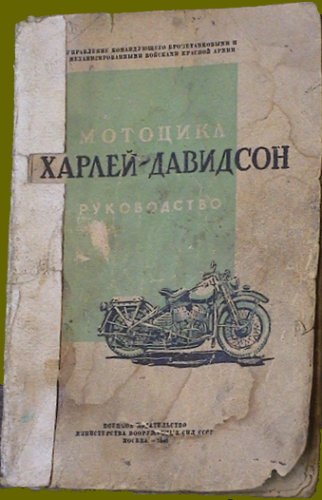
Photo: Semyon Trofimov
(St-Petersburg) via Martin
Bogaert
With over 26.000 WLAs issued to the Red Army, the Ministry of the Armed Forces of the USSR, printed
their own technical manuals.
Note that the cover drawing shows the bike without SMG-bracket and Ammo Box,
although they were mounted on Russian WLAs.
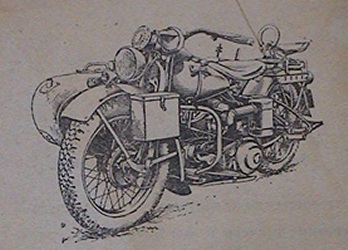
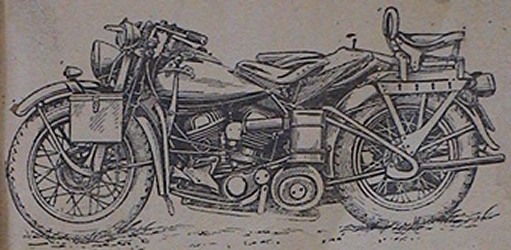
These drawings from the Russian manual show the M72 Type Side-Car and Pillion Seat
The Russians even made their own 'Sportsman' Tires, in a factory in Saint Petersburg.
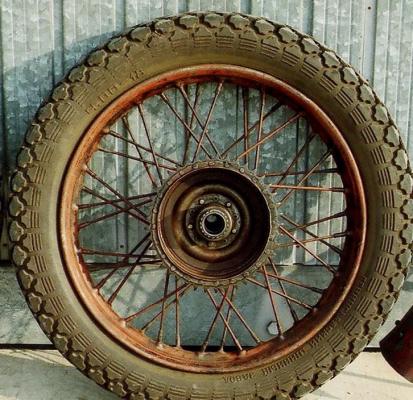
Tire from the Maurizio Beretta
Collection
The M72 Side Car fitted to the WLA by the Russian Army
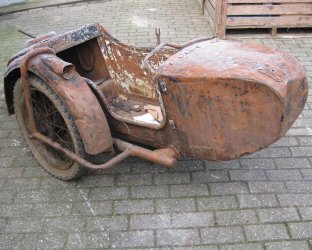
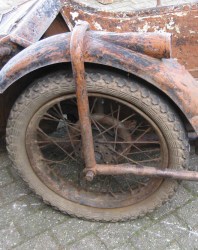
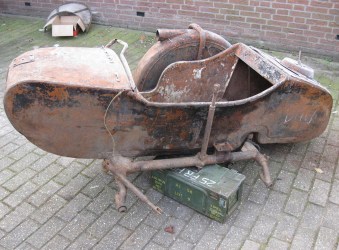
Side Car from the Michel Clements
Collection
Shown above is an original
unrestored M72 Side Car. The tire is a Russian made Firestone Sportsman type in
4.00x18 size.
Note the fender light, which is also visible on the wartime pictures below...
|
'Men and Machine...' A Russian Army 42WLA somewhere
on the Eastern Front in WW2. |
|
|
'Russian
Mortar WLAs' |
|
A Mortar Crew
about to fire their weapon, mounted to WLAs fitted with Side Cars. |
|
'к
Berlin!!' ("To
Berlin") |
|
Russian Troops are speeding past a vehicle column on their drive to Berlin. All
bikes are equipped with a Side Car. |
'Victory'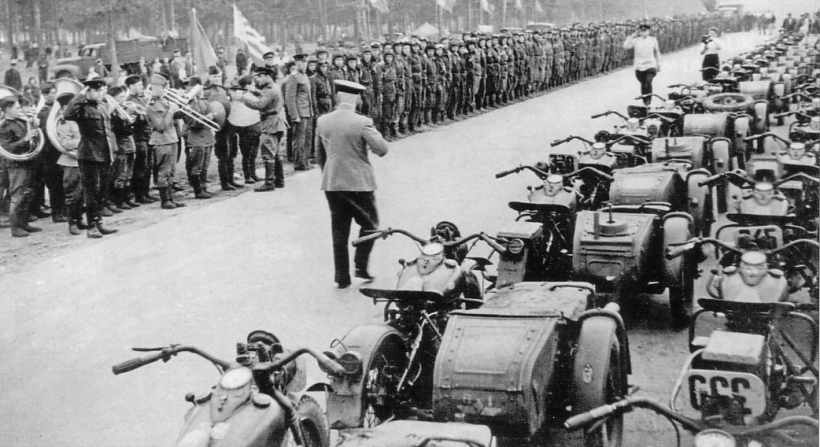 Private photo via Martin Bogaert |
|
At this
Victory parade at the end of WW2, WLAs are lined up with their crews across the
street. |
|
'The mystery
WSR' |
|
The
Model WSR was a prototype designed to be used on the Russian Front. It
was created in 1944 after thousands of WLAs were sent to the Soviets
and was based on the later type 42WLA equipped with a side-car. |
The British Empire
The
'Lend-Lease' figures show that the British Empire received 8.686 45ci
Motorcycles. If indeed they were issued that many Liberators, it's odd they do
not show up on wartime images more often.
Both Australia and New Zealand were issued WLA motorcycles.
The only Harleys in British use that I found were three Royal Air Force WLCs shown below. They were either supplied from Canadian WLC stocks, or were given
as 'Lend-Lease' by the US. The 'Lend-Lease' paperwork does not specify whether
motorcycles were WLA or WLC Models.
|
|
|
Both pictures show Dispatch
Riders of the 83rd Group, 2nd Tactical Air Force (RAF). |
|
'Divisional
Review...' |
|
At Puckapunyal, Australia, members of the 1st Australian Armoured Divisional Provost Company display their riding ability at arview of the division by the Commander-in-Chief of Allied Land Forces, General Sir Thomas Blamey on or around June 20th, 1942. |
|
'Korean War Despatch Rider...' Australian Army WLA motorcycles stayed in service after WW2 and were still used during the War in Korea in the early 1950's. Bob
Parker, a despatch rider with the 3rd RAR Co, poses for a photo with his
Harley. Note the US M1943 shovel carried in the SMG-bracket on the front forks. |
|
France, the country of Lafayette
The Free French Forces, commanded by General De Gaulle, were almost completely equipped by the US. This means they had US uniforms, equipment, weapons and vehicles. They were issued 926 WLA, used by the 1st and 2nd French Armored Divisions.
|
'Return to
France......' |
|
In an English seaport town, a motorcycle unit from the French 2nd Armored
Division, led by General Leclerc, awaits embarkation for the crossing to France
on July 29th, 1944. The French 2AD was attached to Patton's 3rd Army and fully equipped with US made vehicles, equipment and weapons; but these riders wear a mixture of British and US uniforms. All have a British Dispatch Rider type helmet. |
|
'Flowers for the Liberators...' In the small Normandy town of La-Haye-du-Puits, a Harley rider of the French 2nd AD, receives flowers from a local lady in early August 1944. Markings
on his Type IV bike are minimal, and consist only of an Allied star on the
front fender, the Divisional Cross of Lorraine shield and the name 'Lille'
on the windshield. Note the Sportsman tire, low ammo-box and legshields, even during this hot August day. |
|
|
'Paris
is Free!!!!!' |
|
Both
photos above show surrendering Germans and troops from the French 2nd
Armored Division in Paris on August 25th, 1944. The motorcycle rider on the left wears a US HBT uniform with British Made helmet and large leather 'kidney' belt. |
|
'Welcome
Home, General....' |
|
Escorted by motorcycles of the
French 1st Armored Division, General De Lattre de Tassigny, enters the Place de
la Comédie in Montpellier on August 30th, 1944. |
|
|
'Pouvez-vous
me dire la route vers....?' Two members of the French 1st Armored Divsion confer over a map, somewhere in the South of France in the summer of 1944. The bike is a Type III, with a French Army Registration Number painted on the front fender above Invasion Color Bars. Note the 'Skull & Bones' insignia attached to the horn and the Firestone 'Champion' tire on the front wheel. Although the uniforms and equipment are standard US WW2 gear, this rider wears the pre-war french M1935 Tanker's helmet, a common practice with French riders in 1944. |
Chinese WLAs?
One of the greatest mysteries of the 'Lend-Lease' program remain the WLAs which were shipped to China. They were procured by the US Army under the Defense Aid (DA) program in 1941 and as such they did not receive US Army Registration Numbers. 1000 Type I and Type II bikes were delivered to China at the end of 1941 and the beginning of 1942. The only pictures of a 'Chinese' WLA are the Harley-Davidson photo's shown below.
|
|
| 42WLA2580, a Type I, is easily recognised by the high headlight, early round Air-Cleaner and Bicycle style kick starter pedal. |
Força Expedicionaria Brasileira (FEB)
Other bikes
ordered under the DA program were 45 WLA Type II's for the Brazilian Army. They
were supplied with contract number DA-W-398-QM-185 in the beginning of 1942.
In 1943, Brazil joined the war in Europe and deployed the FEB to Italy. The
Brazilian Expeditionary Force saw action in Italy attached to the US 5th Army.
They were equipped with US weapons, vehicles and some uniform items.
The magazine below shows Brazilian riders with their Type II Harleys; note the absence of Black Out Lights. They also wear US style uniforms, headgear and M1938 Resistal goggles.
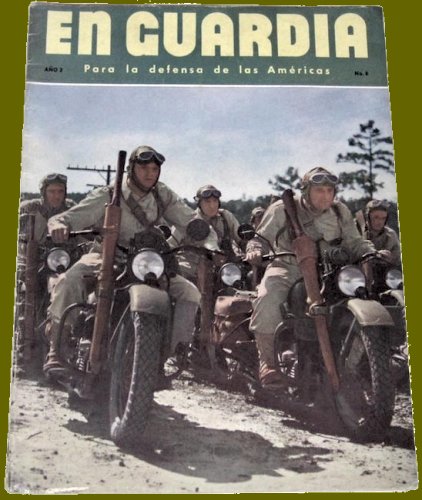
Magazine from the Steve Gregori
Collection
|
|
'Brazilian MP's in Italy...' A Brazilian motorcyclist rides his WLA somewhere in Italy. The bike is a Type II, without the Black Out Driving light. Note the electrical siren mounted on the front fender and the insignia of the unit painted underneath it. |
|
'Brazilian MP's...' Another Brazilian Type II in Italy. The Military Police markings appear twice, once on the windshield and also on the front fender above the Brazilian insignia. MP's of the FEB, were mostly former police-officers of São Paulo. |
|
And the Dutch?...
Before and
during WW2, The Netherlands actually had two separate Armed Forces: the Dutch
Army and the Dutch-Indonesian Armed Forces (KNIL). From the list,
it seems The Netherlands received 420 bikes. Since Holland was occupied until
the last day of the War in Europe and the Dutch Brigade, formed in England, was
completely equipped by the British, it is most likely these bikes were used by
the KNIL. However, again there are only images of WLCs used by the KNIL and they are postwar... another mystery...
Next to these motorcycles, the KNIL were also supplied with Ford GP early Jeeps,
Johnson M1941 Rifles and B25 Mitchell Bombers....
|
|
|
Both
pictures were taken in Indonesia in the immediate postwar period, as evidenced by the
Willys CJ-2A Jeep in the background..... |
Greek Harleys
There is no
doubt Greece was supplied with a large amount of Harley's at the end of WW2.
When I think of Greek WLAs, the picture below shows exactly what I remember. In
the mid-80, piles of WLAs came out of Greece and were sold all over Europe.
Asking price for a complete WLA was about 2.000USdollars back then.... Those
were the days........
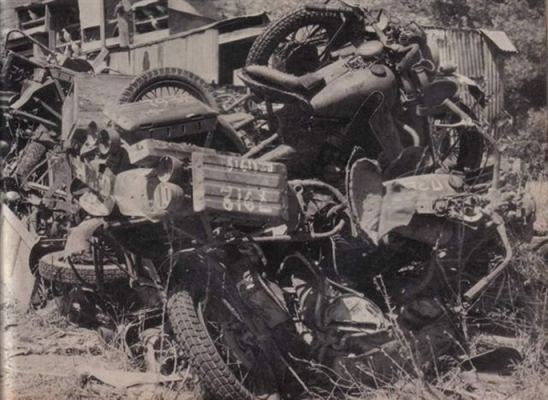
Photo: Stelios Veis
|
|
'Still going strong in 1953...' Greek Army Pvt (Signaler) Michael Litzerinos showing off on a WLA in 1953. The bike looks in remarkable original condition, with only the Black Out Driving light moved to the right side of the front forks... In the past 20 years or so, I have observed several bikes in exactly that condition coming out of Greece.... |
On November 9th, 1943, the United Nations Relief and Rehabilitation Administration (UNRRA) was created . Its mission was to provide economic assistance to European nations after World War II and to repatriate and assist the refugees who would come under Allied control. The picture below shows many WLCs ready to be shipped to Greece for the UNRRA program.... Where are they now???
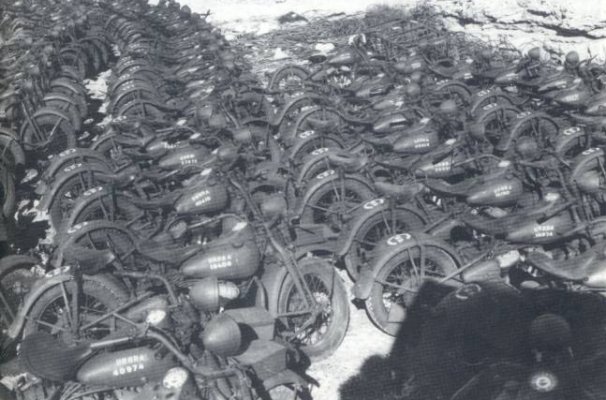
Photo: UNRRA, from Ray
Cowdery's 'All American Wonder II'
Belgium?...
The Belgians, attached directly to the Royal Air Force Military Police units, were equipped with WLC Models. It is however unclear whether these were supplied under 'Lend-Lease' to Belgium, or came straight from RAF supplies. And if they were RAF supply, were they 'Lend-Leased' to the British or supplied thru Canada.......?
|
|
'Belgian WLC...' Herman Wirix poses on a Royal Air Force marked WLC in Germany. Wirix served as a
member of the Belgian Auxiliary Air Police Service (BAAPS) with the RAF. The
bike is a 43WLC Model set up in 'Export' version. A Black Out Shroud has
been added to the Headlight. It is equipped with a windshield with
leatherette apron. The extra stand mounted to the front axle is just
visible. The bike is marked to the RAF Police attached to Tactical Air Force (Police?) Headquarters (TAF PHQ). Note the RAF Registration Number RAF 157554 painted on the oil tank. Crashbars have been painted white... |
If you have more info
or you see errors on this page that you want to see corrected,
please don't hesitate to contact me!
Thanks!